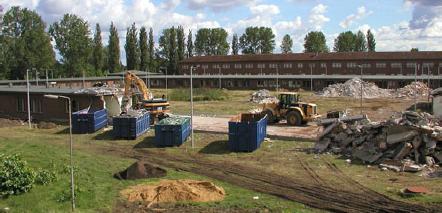History of the Commemorative Sites of Neuengamme
The Neuengamme Monument
A central aim of the Amicale Internationale de Neuengamme (AIN), which was founded in 1958, was the erection of a large, impressive monument. After the 15th anniversary celebrations of the camp’s liberation, the Hamburg Senate finally gave its consent, and in 1963 it accepted aproposal which the AIN had chosen from entries to a competition. The Hamburg sections of the persecutees’ associations officially complained about their exclusion from the negotiations and demanded that the Senate independently finance a more simple memorial. The AIN finally agreed to the Hamburg plans in order not to delay the realisation of a monument any further. But they did insist on setting up the bronze statue “The Fallen Man”, which they gave to the City of Hamburg as a present immediately before the inauguration of the monument on 7 November1965.
The Camp’s Place in Local Memory
In the first two post-war decades, German society mostly ignored its Nazi past. The dominant discourse in Hamburg was that the “Hanseatic spirit” of the city had somehow made the political climate during the National-Socialist period “more moderate” here than else where in Germany. Consequently, very little was said about Neuengamme concentration camp. The actual history of the camp was documented almost exclusively by the survivors themselves. It was not until the end of the 1960s that this situation eventually began to change.
The Document Building
Shortly after the inauguration of the monument in 1965, survivors and visitors expressed the wish for an enlargement of the memorial site. Initially, the Hamburg Senate refused to consent to such plans, but the Amicale Internationale de Neuengamme and the Hamburg Working Committee of Persecutees’ Associations remained steadfast in their demands. In 1979, the Senate finally decided to set up adocument building at Neuengamme. It was inaugurated in October 1981 and housed the first exhibition on the grounds of the former concentration camp. After the exhibition was transferred to the former Walther works building in 1995, the document building was reopened as the House of Remembrance. Today, it houses the documentary exhibition of the names of the dead recorded on lengths of fabric.
Today, there are over 100 memorials, plaques or signs that commemorate the Neuengamme satellite camps and the prisoners who died on the evacuation marches. Until the 1980s, commemorative stones in West Germany were mostly located in cemeteries and were part of an essentially Christian practice of remembering the dead. In East Germany, the remembrance of the dead was, in accordance with the state’s self-image, re-interpreted as acommemoration of the “struggle of the antifascistresistance”. Starting in the early 1980s, many of the sites of the former satellite camps in West Germany were marked with plaques, but only after what frequently amounted to years of campaigning from citizens’ groups. The practice of public commemoration took a turn towards the actual historic sites, and the visual language of memory also changed. New artistic works began to take their place in the culture of remembrance next to the traditional stones and plaques.
The Reorganisation of the Memorial
In 1989, the Hamburg Senate promised to move Penal Facility XII, which was located on the site of the former prison barracks. The implementation of this promise was repeatedly delayed as the Senate cited financial difficulties and problems with the construction of the new prison building at Billwerder-Moorfleet. When a new government took office in Hamburg in September 2001, the realisation of the prisontransfer was again called into question. After much heated public debate, the new Senate revised its decision not to move the prison from the former camp grounds. In June 2003, the grounds of the former prison barracks were finally handed over to the Neuengamme memorial. The demolition of the prison buildings marked the transformation of the grounds into a commemorative site.
